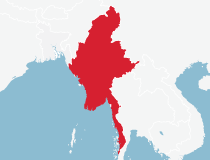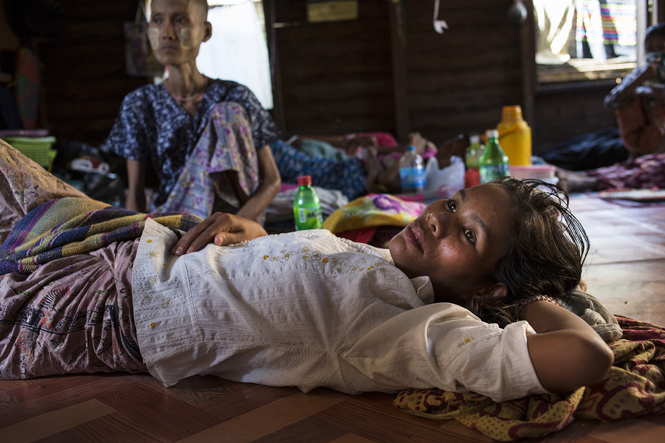WMC Women Under Siege Conflict Report: Burma (2012)

(Jovana Crncevic, with special thanks to the Global Justice Center/published on December 17, 2012)
To begin chronicling the history of sexualized violence in Burma, you have to go back through 50 years of accounts of women suffering subjugation through rape, mutilation, gang rape, and sexual slavery.
Half a century ago, in 1962, General Ne Win overthrew efforts to establish a multiparty democracy in Burma through a military coup and commenced a long line of military junta rule that reaches to the present. Since his takeover, the military regime has dominated the South Asian nation. Burma is home to a diverse, multicultural population and home to many different ethnic groups that speak more than 106 languages and dialects. Burma is administratively divided into seven regions and seven states—the largest difference between them being that whereas states are comprised of mainly one dominant ethnic group (Shan, Rakhine, Kachin, Karen, Karenni, Chin, and Mon), regions are more ethnically diverse. Additionally, Burma’s diverse population observes several religions, including Christianity, Islam, and Buddhism. Religious, ethnic tribal customs and culture determined separate roles and subordinate roles for women in the family, religious life, employment, and decision making in the community, village, or country in Burma. The history of Burma is one replete with a variety of religious and political ruling structures, ranging from monarchies to traditional animist societies, Japanese occupation, British colonialism, small feudal states, democracy, and contemporary military dictatorship.
Religious persecution, ethnic cleansing, forced relocations of indigenous communities, summary executions, arbitrary arrests, the use of civilians as human mine sweepers, slave labor, and gang rapes, occurring particularly in the ethnic states, have been documented by women’s rights NGOs from Burma operating on the Thai/Burma border, as well as by international organizations and bodies, such as Amnesty International and the Office of the High Commissioner for Human Rights.
The military regime has used sexualized violence, particularly against women in Burma’s ethnic states, to quell opposition movements as well as to generally maintain its own power since its inception in 1962. Unfortunately, due to the closed-off nature of the regime, it has been particularly difficult for international organizations, as well as the United Nations, to actively investigate and document these occurrences over the 50-year time span. However, as the United Nations Special Rapporteur on the situation of human rights in Myanmar, Rajsoomer Lallah, affirmed in 1998, “These violations have been so numerous and consistent over the past years as to suggest that they are not simply isolated or the acts of individual misbehavior by middle- and lower-rank officers but are rather the result of policy at the highest level, entailing political and legal responsibility.”

In a massive show of defiance, hundreds of thousands of people marched on August 8, 1988, (8/8/88), to demand an end to military rule. These peaceful demonstrations were violently crushed by army troops who fired relentlessly on the unarmed crowds in the old capital of Rangoon and other cities, killing more than 10,000 students, civilians, and Buddhist monks protesting throughout the country and arresting thousands more.
In the face of international condemnation following the massacre of 8/8/88, the new military named itself the State Law and Order Restoration Council (SLORC), allowed political parties to be formed, and called for a multiparty election. In elections in May 1990, the National League for Democracy (NLD) won a landslide victory, sweeping 392 of 485 (80 percent) of the parliamentary seats. The NLD was led by Daw Aung San Sui Kyi, who had been placed under house arrest prior to the election and disqualified as a candidate by the council. Despite the decisive victory, SLORC refused to transfer power to the NLD, claiming that transfer of power to a civilian government could not happen until peace prevailed in the country.
The “Saffron Revolution” in September 2007 again demonstrated the people’s unequivocal dissatisfaction with the ruling military regime (renamed the State Peace and Development Council, SPDC, in 1997), as the normally “neutral” Burmese monks staged peaceful marches. After an initial period of silence from the junta, the peaceful protests were harshly suppressed by the military, which carried out a brutal crackdown on the protestors. NGOs and the UN Special Rapporteur on the situation of human rights in Myanmar estimated the casualty toll at around 30 deaths. Additionally, the military beat and arbitrarily detained thousands of protestors. Through violent crackdown measures, the regime finally suppressed the massive popular protests against its brutal mismanagement of the country.
In May 2008, the SPDC once again exerted its chokehold on power over the nation as it moved to redraft and ratify a new constitution. The ratification took place through a referendum held a week after Cyclone Nargis—which sources including Human Rights Watch say killed an estimated 140,000 while displacing almost a million more—despite the fact that people could not vote due to the devastation. As the AP reported at the time, the junta delayed voting in some heavily devastated areas but otherwise maintained the original referendum date despite harsh international criticism. A report by the Women’s League of Burma, a Burmese human rights group based in Thailand, cites the Burmese independent publication, The Irrawaddy, when it says that voters in most areas “were commanded to deposit pre-marked ballots approving the Constitution in ballot boxes or face repercussions. Not surprisingly,” the report states drily, “the vote passed with 93% in favor of the new Constitution.”
In addition to the illegitimacy of the ratification process, the constitution granted the junta immunity from any criminal prosecution. Chapter XIV, "Transitory Provisions," Article No. 445 states, “No legal action shall be taken against those who officially carried out their duties according to their responsibilities.” This amnesty provision never appeared in the draft or on items listed for discussion by the National Convention: The junta hastily inserted the provision at the last minute. The constitution also guarantees the military complete legal autonomy over all civilian and criminal military affairs, including impunity for any crimes committed by the military, such as rape.
In November 2010, the Burmese government held general elections for the first time in 20 years. With Daw Aung San Suu Kyi still under house arrest, the NLD boycotted the elections. The Union Solidarity and Development Party, backed by the military regime, won the overwhelming majority of parliamentary seats. Analysts around the world questioned the legitimacy of the elections, with many calling the process a sham portrayal of transfer of power from the military to the civilian government. Daw Aung San Suu Kyi was released shortly after the elections, after nearly 15 years of house arrest.
In the 2012 by-elections, the NLD, under renewed leadership of Daw Aung San Suu Kyi, claimed 43 of the 46 available legislative seats. The NLD’s success has spurred attention from the international community. At the encouragement of UN Secretary-General Ban Ki-moon, the EU and U.S. have eased sanctions and trade restrictions in order to stimulate economic development and sustain the path toward further political reform.
However, despite the shift toward democratic political ideals, the implementation of significant reforms has continued to be curtailed by the considerable power still wielded by the constitutionally insulated SPDC military regime. Although the United Nations Security Council has issued several resolutions urging for the protection of women and children during warfare and conflict, the international community has yet to intervene in Burma’s blatant violation of these legal obligations and enforce its pledge to take the “appropriate steps to address widespread or systematic sexualized violence in situations of armed conflict.” As Burma awaits the realization of these unfulfilled promises, degrading sexualized crimes remain a constant and pervasive reality for the women in its ethnic regions.
Continue to the full report here.
More articles by Category: Gender-based violence, International, Violence against women
More articles by Tag:


























